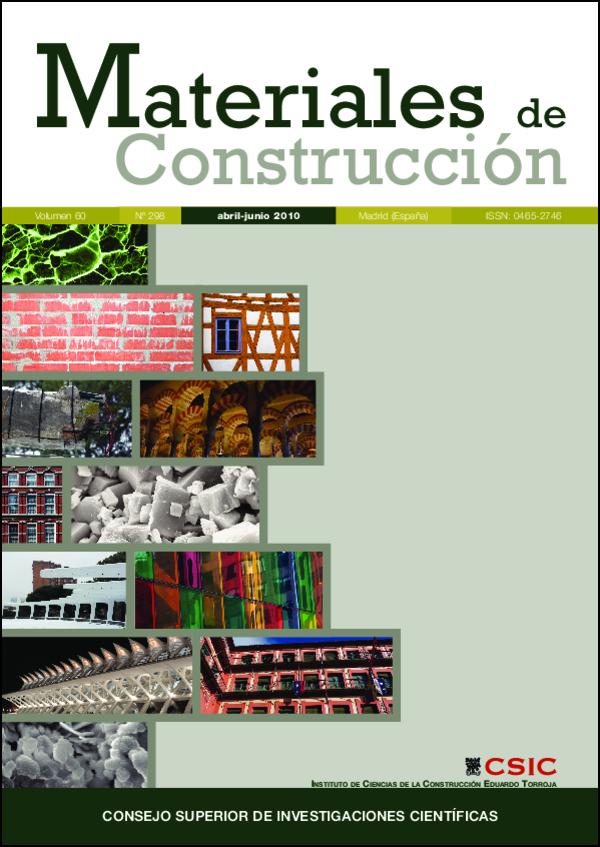Application of experimental plans method to formulate a self compacting cement paste
DOI:
https://doi.org/10.3989/mc.2010.48308Keywords:
rheological properties, ternary diagrams, miscellanies plans method, self-compacting cement pasteAbstract
The self-compacting concrete formulation means to elaborate a self-compacting cement paste to which will be injected aggregates. The purpose of this work is to find the composition of this cement paste containing local materials (pozzolanic cement, limestone fillers, superplasticizer and water) having self-compacting properties. The use of the experimental plans method shows that it is possible to delimit an experimental field bounded by the volumetric proportions of materials composing the paste. The field was transformed in equations form conditioned by implicit constraints, defining zones of minimal shearing threshold and maximum viscosity; numerical resolution submitted to the optimization criteria permitted to define the volumetric proportions of each mixing parameter contributing to the preparation of an optimal paste. After experimental checking to validate obtained results, conclusions are that, from results given by ternary diagrams and desirability’s functions, a composition of an optimal self-compacting cement pas was obtained.
Downloads
References
(1) Xie, Y.; Liu, B.; Yin, J.; Zhou, S.: “Optimum mix parameters of high-strength self-compacting concrete with ultrapulverized fly ash”, Cem. Concr. Res., vol. 32, Issue 3 (2002), pp. 477-480. doi:10.1016/S0008-8846(01)00708-6
(2) Naadia, T.; Mouret, M.; Kharchi, F.: “Effect of the size on the rheological behaviour of the concretes. Application to the SCC”, 1st International Conference on the Technology and the Durability of Concretes CITDUB1, USTHB, Algiers, Algeria (2004).
(3) Kantro, D. L.: “Influence of water-reducing admixtures on properties of cement paste -a miniature slump test”, Cement, Concrete and Aggregates, vol. 2, Issue 2 (1980), pp. 95-102.
(4) Cyr, M.: “Contribution à la caractérisation des fines minérales et à la compréhension de leur rôle joué dans le comportement rhéologique des matrices cimentaires”, Thesé en cotutelle INSA de Toulouse (France) et Université de Sherbrooke (Canada) (1999).
(5) Roussel, N.; Stefani, C.; Leroy, R.: “From mini-cone test to Abrams cone test: measurement of cement-based materials yield stress using slump tests”, Cem. Concr. Res., vol. 35, Issue 5 (2005), pp. 817-822. doi:10.1016/j.cemconres.2004.07.032
(6) Zhor, J.; Bremner, T. W.: “Advances in evaluation of lignosulphonates and concrete admixtures,” Proceedings of the Fourth CANMET/ACI/JCI International Conference, Ed. Mohan Malhota, Tokushima, Japan SP-179 (1998) pp. 1011-1042.
(7) Ferraris, Ch.; Obla, K. H.; Hill, R.: “The influence of mineral admixtures on the rheology of cement paste and concrete”, Cem. Concr. Res., vol. 31, Issue 2 (2001), pp. 245-255. doi:10.1016/S0008-8846(00)00454-3
(8) Phan, T. H.; Chaouche, M.: “Rheology and stability of self-compacting concrete cement pastes”, Applied Rheology, vol. 15, Issue 5 (2005), pp. 336-343.
(9) Bui, V. K.; Akkaya, Y.; Shahm, S.: “Rheological model for self-consolidating concrete”, ACI Materials Journal, vol. 99, Issue 6 (2002).
(10) Ferrara, L.; Park, Y.-D.; Shah, S.: “A method for mix-design of fiber-reinforced self-compacting concretec, Cem. Concr. Res., vol. 37, Issue 6 (2007), pp. 957-971. doi:10.1016/j.cemconres.2007.03.014
(11) El Barrak, M.: “Contribution a l’etude de l’aptitude a l’ecoulement des betons autoplacants a l’etat frais”. Doctorat These. Laboratoire Materiaux et Durabilite des Constructions, Université de Paul Sabatier, Toulouse III, France (2006).
(12) Mathieu, D.; Phan-Tan-Luu, R.; Sergent, M.: Méthodologie de la recherche expérimentale. Criblage et étude des facteurs. LPRAI, Marsella (2000).
(13) Boel, V.; Audenaert, K.; Schutter, G.: “Pore size distribution of hardened cement paste in self compacting concrete. ACI SP 234-11 (2006), pp. 167-178.
Downloads
Published
How to Cite
Issue
Section
License
Copyright (c) 2010 Consejo Superior de Investigaciones Científicas (CSIC)

This work is licensed under a Creative Commons Attribution 4.0 International License.
© CSIC. Manuscripts published in both the print and online versions of this journal are the property of the Consejo Superior de Investigaciones Científicas, and quoting this source is a requirement for any partial or full reproduction.
All contents of this electronic edition, except where otherwise noted, are distributed under a Creative Commons Attribution 4.0 International (CC BY 4.0) licence. You may read the basic information and the legal text of the licence. The indication of the CC BY 4.0 licence must be expressly stated in this way when necessary.
Self-archiving in repositories, personal webpages or similar, of any version other than the final version of the work produced by the publisher, is not allowed.
















